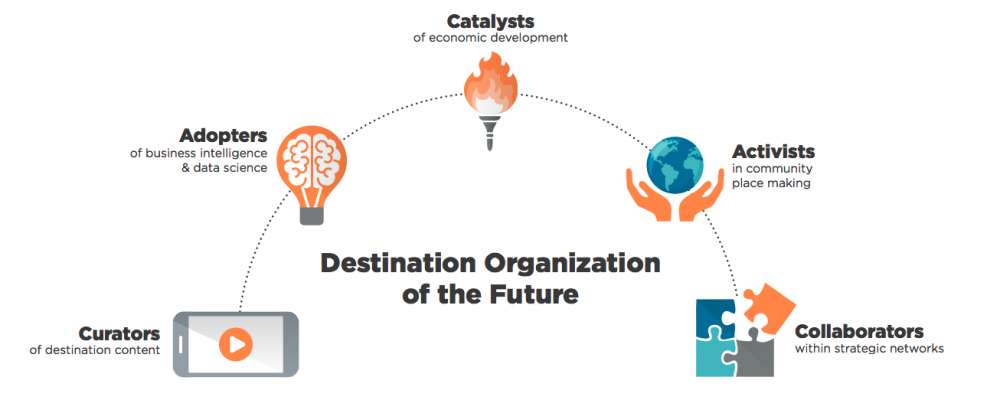This report brings much valuable guidance, but could also risk leading the industry astray if it leads to a tactical, rather than strategic focus. Here’s our take.
The positives: Re-engineering destination organizations is essential.
A quick overview demonstrates how the 2017 report accurately assesses progressive thinking in the industry to identify:
Three transformational opportunities.
- Sales & marketing: shifting from broadcast to engagement and from transactional to strategic.
- Destination management: playing a greater role in product development.
- Business model: greater emphasis on partnerships and collaboration.
Five key roles.
- Curators
- Adopters
- Catalyst
- Activists
- Collaboration

Image source: DestinationNEXT 2017 Futures Study Update, Destination International
We agree that these roles must be a key future focus for DMOs. Organizations need to develop plans for not only what they intend to do (strategy) but how they will do it (structure). In some cases, these roles will be a significant departure from the current reality and will require identifying and nurturing core competencies.
While these trends are all helpful, they can be easily summed up; social media has entirely disrupted our industry.
Don’t be led astray: Seek strategy before tactics
DestinationNEXT paints a clear path from the three transformational opportunities, to new roles for the DMO, to trends. However when we take a closer look at the Top 25 Strategies (on page 16), we become concerned. People might read this report and rely on the ‘strategies’ to make key planning and budgeting decisions. (Note that ‘strategies’ is in scare quotes because many of the 25 listed are actually tactics. See Strategies vs Tactics to differentiate and learn about the danger of tactics without strategy.)
This is where the report is in danger of leading people down the wrong path.
Proceed with caution
Strategies taken from the report may be effective in some situations, but we believe they are best used with a specific understanding of why they are important for your destination. Here are some examples.
1. My organization will invest more effort and resources into video content to market the
destination.
Sure, there is a general trend in online marketing towards video, but that doesn’t automatically make it a strategic priority. How do you know that you need video content to achieve your objectives? What is in the video? Who is the audience? Why is this number one on the list?
2. My organization will focus significant attention to content creation and dissemination strategies.
Content can be important. But to what end? What is the point of doing this? Is the focus still mass attention?
Rather than interrogating the methods and asking “why?”, this laundry list style reverts to conservative marketing that over-extends with blanket promises.
8. My organization will design digital customer engagement primarily around mobile platforms.
What if your destination is in a remote or rural area like Australia’s Outback, where accessing the internet by mobile phone is not always easy? Is this still an important strategy for your consumer?
What if you market to travellers from San Francisco? How can you deliver useful digital information to your savvy consumers that they can’t already find elsewhere? Would this really be the best investment of limited funds?
11. My organization will develop new strategies to refocus on the millennial market.
Marketing to millennials is different from marketing to other generations. But why do we all need to shift to millennials? What if our destination experiences suit older demographics and generations?
17. My organization will put a greater emphasis on market segmentation.
This is good advice, as long as segmentation goes beyond typical broad demographics and geography to gain a true understanding of the customer. In today’s marketing environment, we can all find exactly the right consumer for our destination and move away from appealing to generic, broad audiences (such as “millennials”).
Our industry has been talking about change for over a decade, and this much-needed study will help us adapt. But reports like this leave a gap. The next step isn’t to produce more video. It is to develop strategies that achieve your business objectives, then understand your customer in order to determine tactics.
DestinationNEXT strategies we can stand behind
3. My destination will focus on developing authentic experiences for the customer.
4 My destination will develop ways to connect with customers through all stages of their
experience, from awareness to interest to booking to visiting to post-visit.
6. My organization will enhance our engagement with the local community to manage future
tourism considerations.
13. My organization will connect visitor experience with the quality of life of residents in my
community.
All of these strategies imply collaboration beyond the DMO and allude to key steps that must take place before determining practical strategies. First, determine your best target markets (going beyond a restrictive sense of geographic or demographic markets). Then, map out the customer journey. This is your starting point to determine how to impact your target consumers, and where your organization should focus its efforts. Only then will you know if millennials are the right fit for your investment, and whether video content is needed to help move them through the path to purchase. You will shift away from mass measurements of success toward specifics.
At Destination Think, we build all of our strategies using design thinking, from multi-year plans as in Ottawa, to Place DNA®branding projects as with Gold Coast Tourism, to destination development as with RTO4 in Ontario, Canada. This process helps the DMO build consensus that leads to buy-in and more effective implementation.
As the focus of the 2017 Futures Study progresses, we must be wary of repeating stale thinking in a new medium. This might temporarily abate things from a myopic organizational perspective, but it does not address broader industry realities and fundamentals.
This is the worry that comes to the forefront when the report lists tactics as strategies in a way that could potentially lead our industry astray. There is no simple solution for how destinations need to adapt. Building mobile-friendly platforms or increasing video budget as stand-alone tactics will not do it.
Enabling smart decision making
Here are some strategic elements to consider as you continue to digest the 2017 DestinationNEXT report. These will help your DMO determine the right tactics and continue to evolve with the trends.
- Segment customers based on their interests and passions.
- See DMOs we have worked with like Destination British Columbia, Visit Flanders, and Tourism and Events Queensland for leading examples of best practice.
- Develop visitor personas, know them intimately, then religiously use them to guide all communications.
- Map the customer journey to determine roadblocks and how to impact relevant personas and markets.
- Align the customer journey with your Place DNA (i.e., your destination’s identity) by seeking community input.
- Determine your KPIs based on specific objectives that will affect your personas and their journeys, instead of typical mass advertising goals.
We help destinations with strategic planning and implementation so their stakeholders truly see the value of their investment. Does your organization need guidance while developing and executing future-oriented goals? Get in touch with us today.
Featured image source: Jacopo, Flickr










Love this analysis. This reaffirms much of what we are embracing as an innovative DMO.
Spot on.
I truly like the “seek strategy before tactics part”, and the four defined strategies are so right!